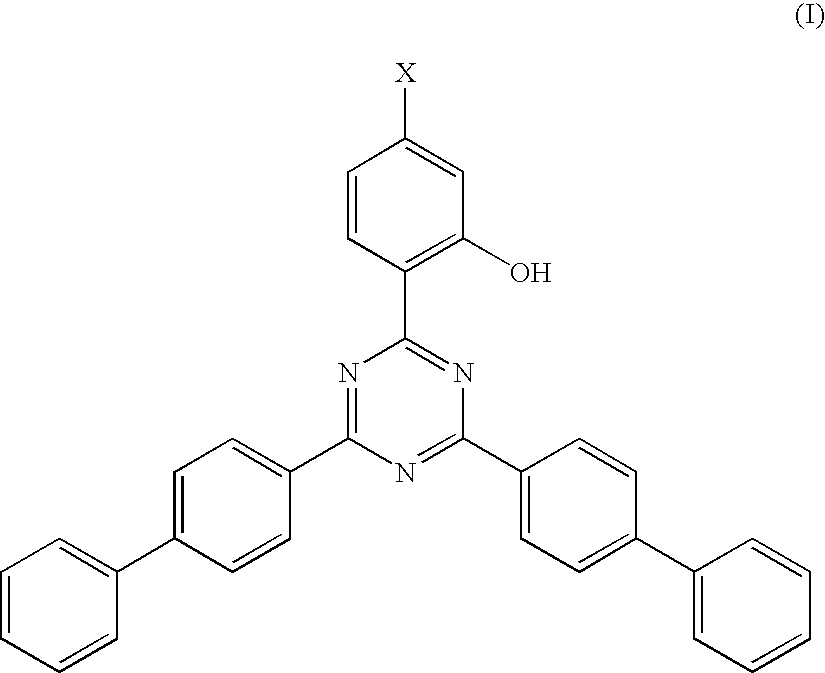Asymmetric multi-layer composites and processes for producing the same
a multi-layer composite and composite technology, applied in the direction of synthetic resin layered products, transportation and packaging, coatings, etc., can solve the problems of low resistance to abrasion and chemical solvents for some uses, yellowing and erosion of the substrate surface, and achieving the effect of low temperature toughness and desirable weathering and scratch resistan
- Summary
- Abstract
- Description
- Claims
- Application Information
AI Technical Summary
Benefits of technology
Problems solved by technology
Method used
Image
Examples
example 1
AS 4700 / AS 4000 (According to the Invention)
[0124]A primer solution comprising the commercially obtainable high-build primer SHP 470 (solids content 9.90%) and a 1:1 solvent mixture of diacetone alcohol and 1-methoxy-2-propanol was prepared by initially introducing 300.0 g of SHP 470 (9.9 wt. % strength) into the mixing vessel and adding in each case 97.5 g of diacetone alcohol and 1-methoxy-2-propanol, while stirring.
[0125]This primer was applied on one side in the flow coating process to 5 mm polycarbonate sheets (injection moulded PC sheets in optical quality from Makrolon® AG 2677 (Bayer MaterialScience AG; medium-viscosity bisphenol A polycarbonate with UV stabilizer and mould release agent; MFR 13 g / 10 min in accordance with ISO 1133 at 300° C. under 1.2 kg)) 10.5×15×0.5 cm in size.
[0126]Coating was carried out by hand. In this case, the liquid SHP470 primer to be used for coating is poured over the sheet in the longitudinal direction starting from the upper edge of the small ...
example 2
AS 4700 / PHC 587 (According to the Invention)
[0129]A primer solution comprising the commercially obtainable high-build primer SHP 470 (solids content 9.90%) and a 1:1 solvent mixture of diacetone alcohol and 1-methoxy-2-propanol was prepared by initially introducing 300.0 g of SHP 470 (9.9 wt. % strength) into the mixing vessel and adding in each case 97.5 g of diacetone alcohol and 1-methoxy-2-propanol, while stirring.
[0130]This coating was applied on one side in the flow coating process to 5 mm polycarbonate sheets (injection moulded PC sheets in optical quality from Makrolon® AG 2677 (Bayer MaterialScience AG; medium-viscosity bisphenol A polycarbonate with UV stabilizer and mould release agent; MFR 13 g / 10 min in accordance with ISO 1133 at 300° C. under 1.2 kg)) 10.5×15×0.5 cm in size.
[0131]Coating was carried out by hand. In this case, the liquid SHP470 primer to be used for coating is poured over the sheet in the longitudinal direction starting from the upper edge of the smal...
example 3
UVHC 3000 / PHC 587 (According to the Invention)
[0133]A coating solution comprising commercially obtainable UVHC 3000 was applied on one side in the flow coating process to 5 mm polycarbonate sheets (injection moulded PC sheets in optical quality from Makrolon® AG2677 (Bayer MaterialScience AG; medium-viscosity bisphenol A polycarbonate with UV stabilizer and mould release agent; MFR 13 g / 10 min in accordance with ISO 1133 at 300° C. under 1.2 kg) 10.5×15×0.5 cm in size.
[0134]Coating was carried out by hand. In this case, the UVHC 3000 to be used for coating is poured over the sheet in the longitudinal direction starting from the upper edge of the small part, while at the same time the starting point of the primer on the sheet is guided from left to right over the sheet width. This is conventionally diluted down before the flow coating in order to reduce the viscosity, Conventional solvents are, inter alia, methoxypropanol, diacetone alcohol or mixtures thereof. After an evaporation t...
PUM
| Property | Measurement | Unit |
|---|---|---|
| thickness | aaaaa | aaaaa |
| impact speed | aaaaa | aaaaa |
| temperatures | aaaaa | aaaaa |
Abstract
Description
Claims
Application Information
 Login to View More
Login to View More - R&D
- Intellectual Property
- Life Sciences
- Materials
- Tech Scout
- Unparalleled Data Quality
- Higher Quality Content
- 60% Fewer Hallucinations
Browse by: Latest US Patents, China's latest patents, Technical Efficacy Thesaurus, Application Domain, Technology Topic, Popular Technical Reports.
© 2025 PatSnap. All rights reserved.Legal|Privacy policy|Modern Slavery Act Transparency Statement|Sitemap|About US| Contact US: help@patsnap.com

